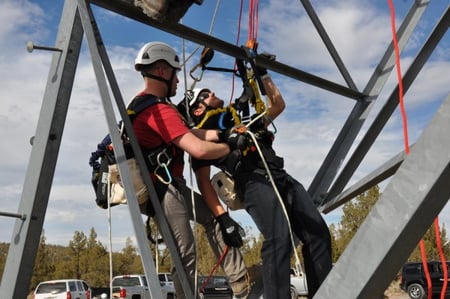
Inspection services come in many different shapes, styles, and sizes offering a range of services, deliverables, and values. A disturbing trend that I see occurring more and more often is the “staffing agency” approach to inspection services. My opinion (based on years of observation) is that this approach undermines the overall quality process by not providing real value.
The Low End of the Spectrum
So what do I mean by “the staffing agency” approach? This is when a company provides an inspector and that’s it; no training, no technical support, no processes, no documentation, in some cases not even personal protective equipment (PPE), and very rarely a solid understanding of quality control (QC) vs. quality assurance (QA) and how they work together to provide overall quality. The staffing agency approach would be the low end of the quality inspection spectrum.
The High End of the Spectrum
The other end of the spectrum involves an approach with more depth and more layers of overall quality and support, thus yielding a far superior product. This high end of the spectrum involves a company that hires qualified inspectors, trains those inspectors in a proven quality process, reviews and monitors their deliverables, and provides feedback for continued improvement.
Additionally there are at least 2 layers of background support for these inspectors. The first layer of support should come in the form of a direct manager for the inspector(s). Call this position a resident engineer or assistant project manager or something to that effect. The title isn’t as important as what this person does. Essentially this Resident Engineer (RE) works with the inspectors and with the customer to monitor the overall quality to ensure value for the customer and support to the inspector. They act as a liaison between the inspector, the contractor, and you – the customer.
The second layer of support is the overall quality manager who oversees these RE’s, ensuring they have what they need as well as performing a higher level of overall program monitoring.
These two layers work together to provide both Quality Control and Quality Assurance for the inspector, the service you’re paying for, and ultimately for your project. This is where the “Value” of a quality inspection service really starts to become obvious. It’s the whole package including processes and an extensive support network which is far superior to simply providing a warm body. Consequently, this higher end approach doesn’t necessarily translate to more expensive - again we’re speaking about value here and ultimately you get what you pay for. If you’re going to outsource your inspection and/or construction management, it’s well worth it to aim for this end of the spectrum.
Here are a few questions to ask yourself when rating your current inspection services:
What training do my inspectors require, are they current on this training, and who provides it?
What safety certifications do you require? What current, trade specific training do you require? Do you enforce a safety plan? You may require your inspectors to have some industry safety certifications (OSHA 10, Climbing certifications, First-Aid CPR, etc.), and maybe you require certain computer skills as well. How will you ensure your inspection force is current in their training?
This is where the staffing agency approach falls short every time. The staffing agency has no real “dog in the fight” so to speak and the burden of this requirement is either ignored or passed on to you.

What level of support do your inspectors have?
At the lowest level of the “Inspection Spectrum” is the inspector who shows up in the morning and leaves in the afternoon having only observed the work being performed, nothing more. At the opposite end of that spectrum is an inspector who represents you and your specifications, is entrenched in the entire project, acts as your eyes and ears on the job and documents in detail all that they observe. The cornerstone of this highest level of inspection services is the background support provided to these inspectors, the resources that come along with their inspections. Think of it like technical support for that new flat screen TV you’re trying to hook-up. Would you rather have no background support, or a technically savvy support network that knows the intimate details of your project and is ready with solutions?
Are your inspectors producing any deliverables and are these deliverables audited regularly?
At a bare minimum your inspectors should be completing a daily inspection form. This form should allow for essay style documentation rather than just simple check boxes. Additionally they should also be completing documentation for several phases of inspection for each definable feature of work on your projects including final inspections. However, what’s really important here is that these documents are being reviewed, daily, for accuracy and to assist the inspector in improving his or her writing skills and level of documentation. This is where the Resident Engineer and Quality Program Manager roles come into play and add real value. Are your inspectors being monitored, are they receiving feedback and constantly improving?
Is the level of quality on your project being accurately documented?
To answer this question, ask yourself whether or not a specification for a definable feature of work was followed by the construction contractor. You should come up with either a yes or a no answer. Again, this is where the value of your inspection services comes into play, when you have documented proof to back up your yes or no answer.
Let’s say a feature of your project was improperly installed and you would like the contractor to go back and fix it. What documentation do you have that proves it was installed incorrectly? How much time are you willing to spend arguing and how much of the repair cost are you willing to split with the contractor? A good inspection service will highlight a non-conformance item and see that it is fixed in real-time to prevent the whole process of going back and fixing something after the project has closed. This is better for you and your contractors. This is also a safety item - It’s statistically proven that re-work is a far greater hazard than fixing an issue in real time.

Think about the arguments that may come at a later date long after construction is completed and you’re in the warranty phase of the work. How will you prove non-compliance on the part of your contractor? The answer is documentation! With the staffing agency approach, you may not get all the documentation needed to protect your interests.
What are your average costs per project for change order requests (COR’s)?
It’s no secret that many contractors bid low with the assumption that costs will be recouped via change order requests as the project progresses. We all understand the nature of construction and how many variables can and will change during the course of a project. However, there is a contract in place as well as blueprints, specifications, drawings, etc. When these rules are followed and enforced, the legitimate amount of COR dollars goes way down.
Believe it or not, high quality inspection services can and will pay for themselves over and over again simply by providing you with the ammunition to combat fraudulent or less than accurate COR’s. Good documentation of verified quantities, equipment actually on site, hours worked, material flaws, etc. can help you paint a very accurate picture of your worksite long after the work is completed. This is also a benefit to your contractors and helps a project flow from beginning to end by minimizing down time. If your “staffing agency” inspector hasn’t completed any documentation or simply pencil whipped a form, you’ll have a hard time holding onto your dollars when push comes to shove!
The ideal approach to inspection services goes much deeper than simply having an inspector on-site. It should involve additional layers of background support. These support roles assure your inspectors are providing a high-end service and are producing valuable deliverables. Additionally these layers of inspection services assist your project PM’s with COR’s, RFI’s and many other items that ensure your projects progress smoothly from kick-off through billing and close-out. Value in inspection services is:
- Recognizable by the overall quality it provides your project and the project outcome.
- Visible in the assistance it brings to other aspects of project management like billing, COR’s and RFI’s.
- Tangible and results in your projects being completed on time and on budget, but most importantly with a high level of quality and safety and with the least amount of headaches.
It is worth your time to review your current inspection provider and determine which end of the spectrum they’re on. Are you using a staffing agency or are you investing in value?
What has your experience been when using a “staffing agency” approach versus value-added inspection? I’m interested in hearing your thoughts!
Photo credit: (header photo) Adobe Stock / yuttana590623

